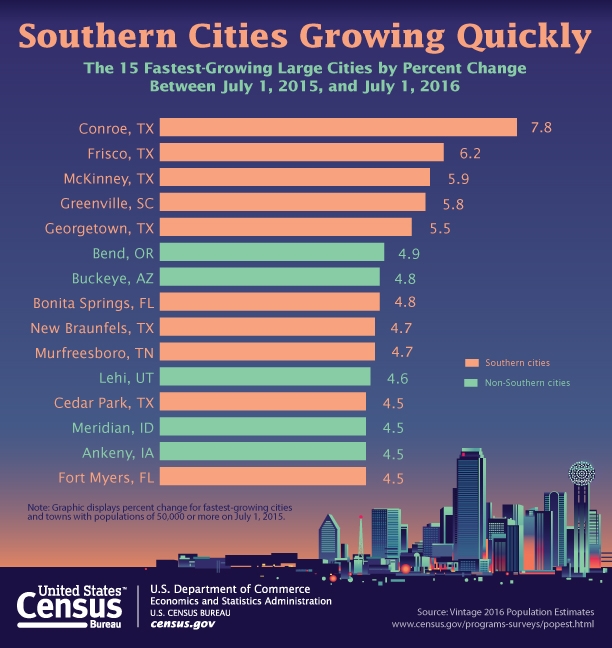Texas Cities Continue to Top the Charts

MAY 25, 2017 — Ten of the 15 fastest-growing large cities were located across the South in 2016, with four of the top five in Texas, according to new population estimates released today by the U.S. Census Bureau.
Conroe, Texas (near Houston), was the fastest-growing large city (population of 50,000 or more) between 2015 and 2016 at 7.8 percent, making its growth rate more than 11 times the nation’s growth rate of 0.7 percent. Some of the other fastest-growing cities were: Frisco, Texas (6.2 percent); McKinney, Texas (5.9 percent); Greenville, S.C. (5.8 percent); and Georgetown, Texas (5.5 percent).
“Overall, cities in the South continue to grow at a faster rate than any other U.S region,” said Amel Toukabri, a demographer in the Census Bureau’s population division. “Since the 2010 Census, the population in large southern cities grew by an average of 9.4 percent. In comparison, cities in the West grew 7.3 percent, while cities in the Northeast and Midwest had much lower growth rates at 1.8 percent and 3.0 percent respectively.”
Four cities in the West — Bend, Ore.; Buckeye, Ariz.; Lehi, Utah; and Meridian, Idaho — were among the top 15 fastest growing. Only one city in the Midwest, Ankeny, Iowa, topped the list while no cities in the Northeast were among the nation’s fastest growing.
The statistics released today cover all local governmental units, including incorporated places (such as cities and towns), minor civil divisions (such as townships) and consolidated cities (government units for which the functions of an incorporated place and its parent county have merged).
Later this summer, the Census Bureau will release additional population estimates by age, sex, race and Hispanic origin for the nation, states and counties.
Find more highlights from this year’s release below and local-level statistics on census.gov. Tag @uscensusbureau in stories and email <pio@census.gov> to interview a subject expert.
Columbus, Ohio, Surpasses Indianapolis to Become the 14th Most Populous U.S. City
While the overall list of the 15 largest U.S. cities did not change since 2015, Columbus, Ohio, surpassed Indianapolis, Ind., becoming the 14th largest city in the United States with a population of 860,090. Indianapolis has a population of 855,164.
- New York remains America’s largest city by a wide margin. Its July 1, 2016, population of 8.5 million makes it more than twice as large as the next largest city, Los Angeles.
- Los Angeles remains the second-largest city, with a population of about 4 million. Despite a population loss of 8,638, Chicago remains the third-largest city, with a population of 2.7 million.
- Phoenix, Ariz., had the largest numeric increase of any city, by adding 32,113 (about 88 people per day on average) between 2015 and 2016.
Population Change in Small Towns and Regional Differences
Of the 19,510 incorporated places in the United States, around 76 percent (14,801) had fewer than 5,000 people in 2015, whereas only 3.9 percent (752) of cities had a population of 50,000 or more. Since 2015, on average, these small towns have seen uneven growth across U.S. regions:
- Northeast small towns declined by 0.5 percent.
- Midwest small towns declined by 0.3 percent.
- Small towns in the South grew by 0.2 percent.
- Western small towns saw the largest growth with an increase of 0.8 percent.
Midsized cities in the Northeast, places with populations between 5,000 and less than 10,000, experienced relative stability, seeing a small average decline of 0.1 percent since the 2010 Census. Midsized cities in the other regions experienced population growth, on average.
Crossing Population Milestones
- League City, Texas, was the only city to cross over the 100,000 population mark in 2016, reaching 102,010.
- Five cities crossed the 50,000 population mark between 2015 and 2016. All five areas are in the West:
- Aliso Viejo, Calif. (51,424)
- Parker, Colo. (51,163)
- Logan, Utah (50,676)
- Cerritos, Calif. (50,555)
- Coeur d’Alene, Idaho (50,285)
The nation’s housing stock grew by 911,000 last year to reach 135.7 million. The growth rate of 0.7 percent last year was roughly half of what it was in 2007 (1.4 percent). Housing unit growth last year remained below pre-2007 levels in nearly all states except North Dakota (up 1.6 percent last year, compared to a 0.9 percent increase in 2007), the District of Columbia (up 1.4 percent, compared to a 0.9 percent increase in 2007) and Iowa (returning to the 2007 level of 0.7 percent growth).